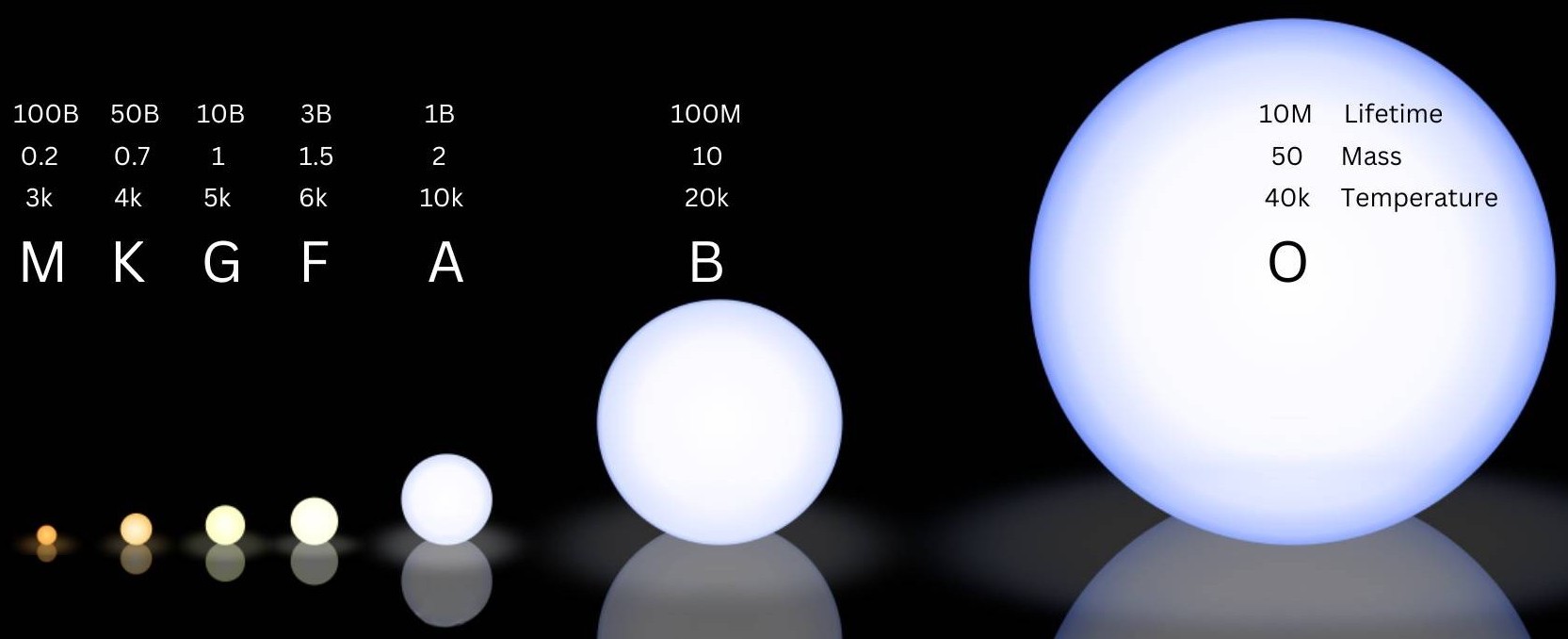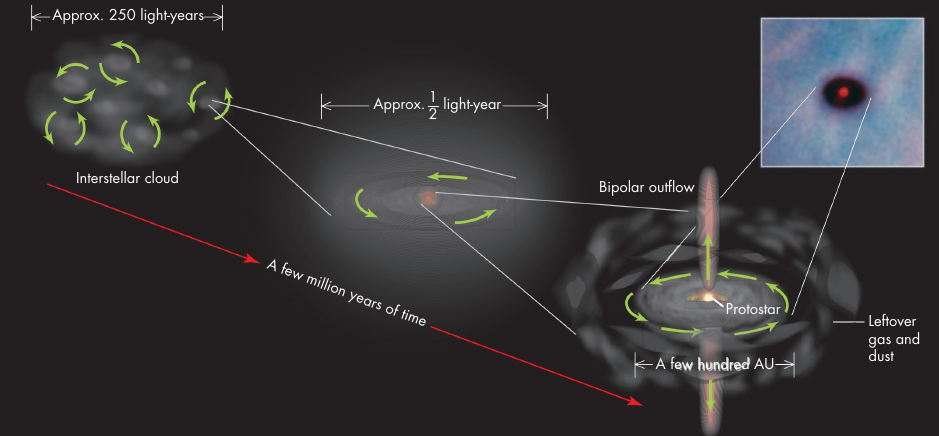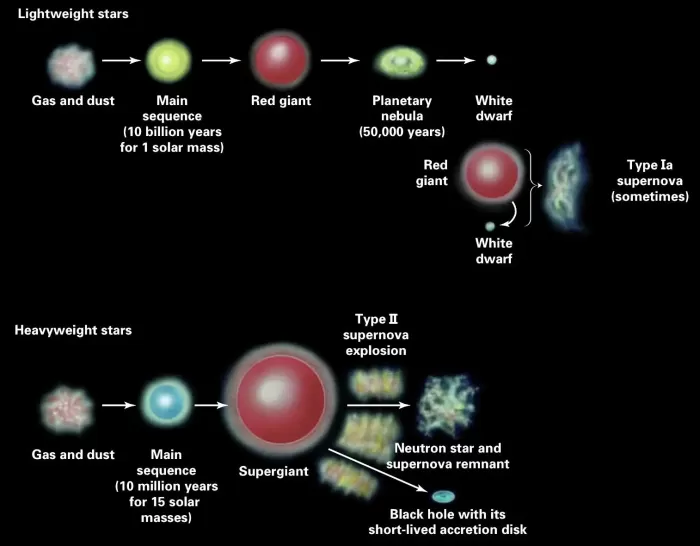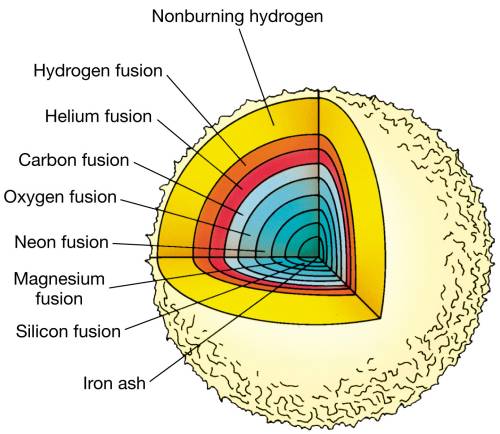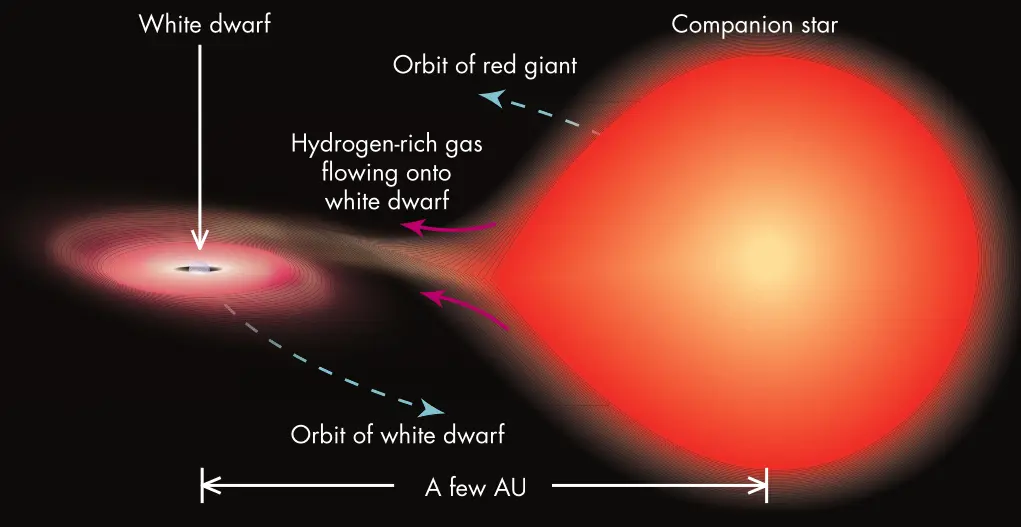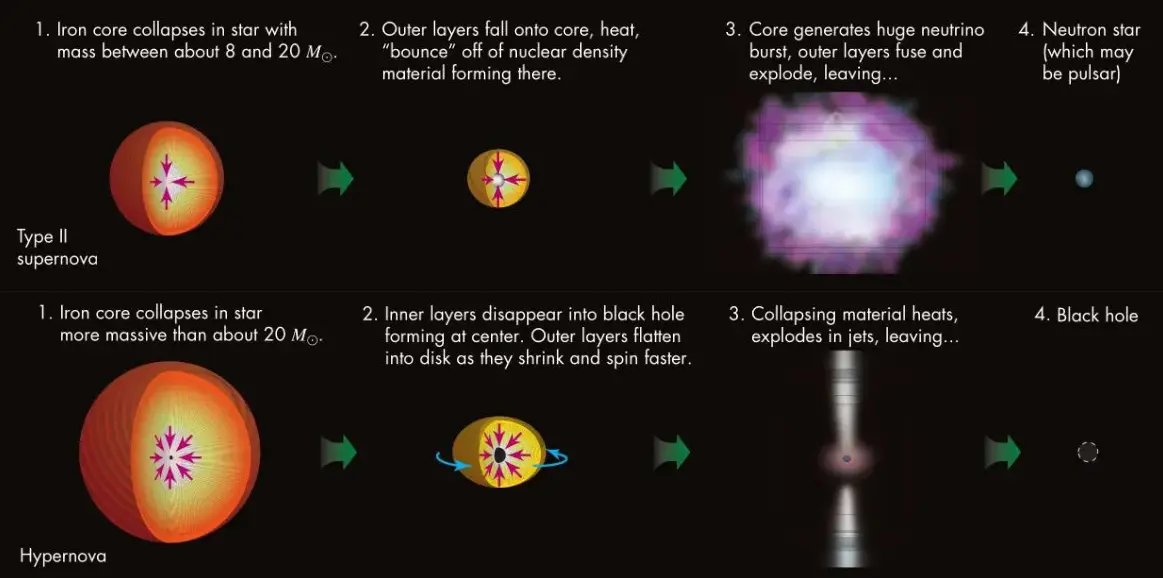Cosmic star formation history
Hans Rosling, a Swedish physician of the Karolinska Institute (that awards the Nobel Prize in Medicine), created Gapminder to popularize the history of the countries using the statistics of their human population. Similarly, we can write the history of the universe using the statistics of its stellar population. Gapminder emphasizes two statistics: the amount of production (GDP, related to birth and creativity) and the life expectancy (related to death) and we will take care of two quantities for stars: the star formation rate (SFR) related to the birth of stars and the black hole accretion rate (BHAR) related to the death of stars.
As you see in the figure, SFR and BHAR closely follow each other throughout the 14-Gyr (giga/billion year) history of the universe. The lookback time is the time before present. Redshift is related to lookback time and the quantity on the vertical axis is related to the total mass of all the stars born or expired per year within a cubic volume of the universe. This quantity is symbolized by $\Psi$, but it is fine if the values of $\Psi$ do not make sense to you; just note that as you go higher along the vertical axis, the value of $\Psi$ increases. Here SFR is shown using the thick black line, and BHAR using the thin red line.
So if you start from around 14 Gyr ago (right corner of the horizontal axis) and move to the left toward the present time, you clearly see that both SFR and BHAR increase with time, reach their peak value around 10 Gyr ago, and then decrease until the present time. Here is the physical interpretation of this result. New stars form from the gas of the disk in a galaxy and the supermassive black hole at the center of the galaxy swallows gas and stars. More stars form when more gas are available and, if there are more available gas, the black hole will also accrete (swallow) and destroy stars and gas more. So birth and death go hand in hand, somewhat comparable to what happens in human populations.
Population I and Population II
Walter Baade was a German astronomer who moved to the USA in 1931 to work at the Mount Wilson Observatory in Los Angeles, the largest telescope in the world at that time. As Los Angeles grew bigger, light pollution from the city made observations from Mt. Wilson difficult. But in the 1940s there were a lot of blackouts during the night and Baade took this opportunity to take photos of all the neighboring galaxies. He saw that the stars in these galaxies had two distinct peak colors: some stars gave more red light and some more blue light. He called the red stars Population II and the blue ones Population I. Note that all stars produce light of all colors, but the color with the highest intensity varies from star to star depending on their temperature. Bluer stars are hotter, redder stars are colder. The same division of stars was also found for the Milky Way, our galaxy.
Baade saw that the red Pop II stars are found only in the bulge and halo whereas the blue Pop I stars are found only in the disk, especially in the spiral arms. The Pop I stars revolve around the center of the galaxy in almost circular orbits, but the Pop II stars have highly elliptical orbits, they sometime come very close to the center, sometimes go extremely far crisscrossing and plunging through the disk. Check the second figure in the slider using the arrows and you will see the difference in their orbits. Pop I stars are younger, Pop II older.
Pop I stars, like the sun, are completely made of hydrogen and helium (97%), but 3% of their mass comes from heavy elements, mainly carbon and iron. Pop II stars are more dominated by hyrdogen and helium, the heavy elements constitute only a few hundredths of a percent of their mass. So the metallicity (abundance of elements heavier than helium) of Pop II stars is almost a hundred times smaller than that of the sun.
The two populations are so different probably because of their year of birth. Older generations are very different from the younger generations among humans. Similarly, maybe the Pop II stars are so different because they form in a single burst of star formation very early, almost during the formation of the galaxy itself. They are the old generation. The Pop I stars formed later and keeps forming even now. Pop I stars are the young generation and the generations to come. But unlike the humans, the older Pop II stars seem to be more erratic than the young Pop I stars.
Types of stars
Galaxies could be classified based on their shape, but the same cannot be done for stars because they all have the same shape: spherical, perfectly round. So we classify stars based on their surface temperature. The temperature on the surface of the sun is around 5,000 (5k) degrees, and we call it a G-type star. G-type stars typically live for 10 billion years.
Lifetime, mass and temperature of a star are directly related. Hotter and heavier stars die early, colder and lighter stars live long. The types F, A, B and O are hotter than the sun. O-type stars are 50 times more massive than the sun with a surface temperature of 40,000 degrees, but they live for only 10 million years. The types K and M are colder and lighter than the sun. M-type stars have a temperature of only 3,000 degrees and a mass of only 20% of the sun, but they live almost 100 billion years.
Birth of a star
Stars are born from giant clouds of gas and dust inside galaxies, mostly in the disk and spiral arms. If the mass, density and size of a certain cloud in the interstellar medium (gas between the stars) becomes high enough, it collapses and contracts toward its own center because of gravitational force. All clouds have some rotation to begin with. Rotation tries to disrupt and flatten the cloud, gravity tries to make the cloud smaller and more round. The battle between rotation and gravity gradually creates a star within a few million years as shown in the figure for one such cloud.
Just as a round pizza dough becomes flat when you rotate it using your hand, the rotation makes the cloud flat. But most of the gas gather at the center of the cloud and there rotation cannot defeat gravity. Whenever gravity wins, things become more spherical and round. So at the center the embryo of a star is born out the dense collection of gas. The flat disk of gas and dust will fragment into planets which will be discussed during the planetary age.
Within the star itself two opposing forces fight each other: inward gravity (G) and outward gas pressure (P). In the beginning G and P are not equal, hence the star cannot stabilize. It keeps gathering gas from the surrounding disk, swallow parts of it and eject the rest through two outflows from its two poles. A round volume of gas with such bipolar outflows is called a protostar. When the protostar eats up all the gas close its surface, the outflows turn off, but it cannot stabilize yet because P by itself is not strong enough to withstand G.
The protostar becomes a star when the hydrogen at the core begins to turn into helium via fusion, a type of nuclear reaction or burning. Helium was produced from hydrogen through the same mechanism within the first 15 minutes after big bang. We call something a star if it can act like its mother the big bang, if it can produce helium in its womb the way its mother did in the first 15 minutes. Because the light created by the nuclear burning produces a farther outward pressure called the radiation pressure R. P and R together act against G and stabilize the star. The condition for becoming a star is thus this:
$$ G = P + R. $$
The life of lightweight (similar to the sun) and heavyweight (heavier than the sun) stars are different as shown in the top and bottom panels of the figure, respectively. Both types form from clouds of gas and dust and become a main sequence (MS) star when G=P+R stability is established.
Lightweight stars live for about 10 billion years with this stability. Then they run out of hydrogen (H) at the core: nuclear burning stops, R becomes zero, P alone cannot withstand G, the star contracts and heats up. A shell surrounding the core becomes hot enough (10 million degrees) to burn H to He (see next figure in slider). And the core becomes hot enough (20 million degrees) to burn He into carbon (C). The core-burning of He and shell-burning of H produce a lot of R. P+R becomes higher than G, the star expands and become a red giant. Red because the it cools down after expanding and cooler stars are redder.
Eventually the core runs out of fuel and shrinks, but cannot burn anything heavier. The atoms of the elements break down due to gravitational shrinking and too many electrons are squeezed into too small a space creating a huge outward pressure P. This P equals G and stabilizes the core. The core with G=P stability is called a white dwarf. White because the temperature is too high. The expanding envelope surrounding the core disperses into the interstellar space creating a planetary nebula. The nebula looks like an eye with the white dwarf as its pupil. Examples include Helix nebula and Dumbell nebula. The white dwarf and red giant created from a binary star can explode as a Type I supernova.
Heavyweight stars live a shorter but more interesting life. They run out of core H sooner because they burn faster. When it happens, R becomes zero, P alone cannot withstand G, the star shrinks and heats up. At higher temperatures, He turns to C in the core and H turns to He in the surrounding shell, similar to the lightweight stars. When core and shell run out of fuel, the star shrinks again making the star even more hot. The core C turns to oxygen (O), He turns to C in the first shell, and H to He in the second shell. Because of successive shrinking and heating, the core of the star is fragmented into many shells. But core burning stops when the inner core turns into iron (Fe).
At this point, heavyweight stars do not have enough R, P alone cannot withhold G, the star shrinks and heats up, shell burning produces a lot of R, P+R overcomes G and the envelope of the star expands into a supergiant, but the core collapses onto itself. During the collapse, farther nuclear burning and extreme pressure battle the inward gravity leading to a division of the core into an inner core and an outer core. The outer core collapses onto the denser inner core and bounces off with a gigantic explosion called a Type II Supernova or core-collapse supernova. More about this below.
Lightweight stars produce nothing much heavier than carbon, but heavyweight stars can cook many heavy elements up to iron (Fe) in their nuclear oven. After H runs out in the core, burning stops, star shrinks leading to a heating of the core and a surrounding shell. The core converts He to C, the shell H to He. When all He turns to C in the core and all H turns to He in the shell, nuclear reactions stop leading to farther shrinking and subsequent heating of the core and two surrounding shells. Using the extra heat, the core now converts C to O, the first shell converts He to C and the second shell H to He. When the C, He and H fuels are finished in the core and the shells, fusion stops and the star shrinks again leading to more heating.
At this higher temperature, the core and the first three shells are ignited. The core converts O to Ne, the first shell C to O, the second shell He to C and the third shell turns H to He. This process continues. Next shrinking and heating leads to a core that converts Ne to Mg and four shells producing Ne, O, C and He, respectively. When these five fuels are also used up, the shrinking and heating lead to a Mg-burning core and five shells turning Ne, O, C, He and H into Mg, Ne, O, C and He, respectively. The Mg-burning core gets richer in silicon (Si). During the next heating, the Si core is burnt to iron (Fe) ash and seven cores surround the Fe core burning Si, Mg, Ne, O, C, He and H in simultaneously. When all these fuels are used up, the star cannot continue nuclear fusion any more because it takes more energy to burn Fe than the resulting output. If the required input energy is more than the output energy needed to stop the inward invasion of gravity, the star cannot continue the process because the business becomes unprofitable.
But there are many chemical elements heavier than Fe as you can see in the periodic table embedded in the page of Chemical Age. Where did they come from? The answer lies in the explosions mentioned above. During a core-collapse supernova explosion (Type II), two important things happen. The outer core explodes and all its chemical elements are scattered into interstellar medium making it rich in chemicals. These heavy chemicals are later used for making metal-rich stars and biodiverse planets. The other important contribution of a supernova is that many heavy elements are created in a matter of seconds during the explosion. Note that elements heavier than Fe needs more energy than is profitable, but during the explosion so much energy is available that the star does not need profits anymore. If you have too much money, you can waste all you want. Gold (Au) and silver (Ag) are created during supernova explosions. If you are wearing a gold ring, you are literally wearing a supernova product.




